I wrote some articles earlier this season pertaining to a couple of current buzzwords- spin rate and Bauer Units. Discussions abound concerning pitcher’s spin rate (and/or axis) and how it applies to pitch effectiveness. Sometimes fanatically so, velocity is deemed ‘king metric’ which can cloud other downplayed factors. Make no mistake, velocity has its value but to imply a pitcher fails or succeeds due to velocity increase/decrease is ignoring many variables (sequencing, location, etc). Bauer Units come in to try to encompass all of this in order to better understand how a four-seam fastball should be used (its applied to other pitches as well). BU’s are reached by dividing (average) spin rate by (average) velocity. The average four-seam velocity is 92 MPH with 2200 RPMs considered the median spin rate. When calculating a BU score using those metrics, you come up with a mean of 24. The creators of BUs, Driveline Baseball, uses it in the following way:
League average Bauer Units -> look into developing a 2-seam
Above average Bauer Units -> try to throw middle/up in the zone
Below average Bauer Units -> try to throw middle/down in the zone
One important thing to mention is BUs are more useful for pitchers in high school, college, and perhaps the low-level minor leagues. However, this does not mean we can’t apply it to and evaluate Major League pitchers. I found a good example of how this measurement, and some thoughts on spin rate itself, can be flawed.
The 2018 Milwaukee Brewers had one of the best relief pitchers in baseball with Josh Hader. He was the third-ranked reliever in WAR, struck out an incredible 47% of batters faced, was second overall by a fair margin in SIERA (1.70), and had the lowest rate of contact in the strike zone (67.8%). Hader was an incredibly valuable weapon for the Brewers in the postseason, mainly due to his elite fastball and how he supplemented it with a slider. Of pitchers who threw at least 50 innings in 2018, Hader’s four-seam fastball ranked seventh overall in Pitch Value (19.7 wFA) and third when the pitch is scaled to 100 (1.89 wFA/C).
A brief explanation of pitch values are provided by Fangraphs:
The first category is the total runs above average that a hitter has contributed against that pitch or total runs saved by a pitcher using that pitch. However, it is tough to compare these total numbers since hitters see different amounts of each pitch. The second category corrects for this, standardizing the values on a “per 100 pitch” basis. In other words, when you see wFB/C, that represents the average amount of runs that (pitcher saved) against 100 fastballs thrown.
Hader’s average fastball velocity is 95.1 MPH and his spin rate is 2043 RPMs. That scores a 21.5 on the BU scale. Since the average BU score on four-seam fastballs is 24, and Hader’s BU is considered below average, Hader should probably be throwing his pitch lower in the zone. Again, its hard to say how iron clad this metric is, but let’s roll with the BU premise.
Generally speaking, with some regard to velocity, if you have a high spin rate on your fastball, conventional wisdom would say you’d want to keep it up in the zone. Reason being is Magnus Force is affected by spin rate, especially the backspin on four-seam fastballs. The high spin keeps the ball on a (somewhat) even trajectory and can even appear to rise in a hitter’s mind’s eye. I’ve gone down this road before and more information can be found on Driveline’s site.
So what does Hader do with his four-seam? What happens in certain locations? Chart 1 breaks down each section of the strike zone.
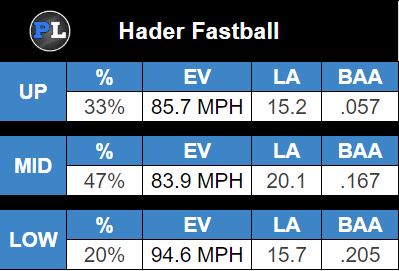
CHART 1
We can see that Hader is much more successful up in the zone. In fact, the exit velocity difference is nearly 10 MPH while keeping in mind sub-90 MPH EVs produce next to no home runs. Yet BUs would suggest he keep his fastball down.
Charts 2 and 3 display Hader’s batting average allowed and whiff rates, respectively (minimum 5 swings).
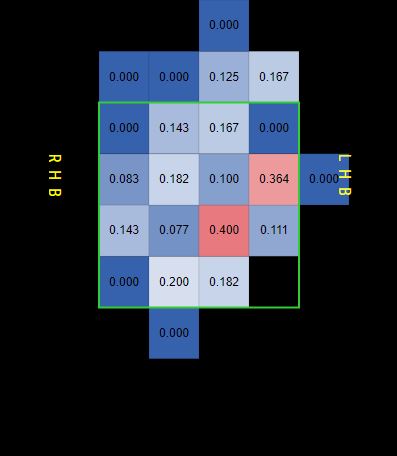
CHART 2
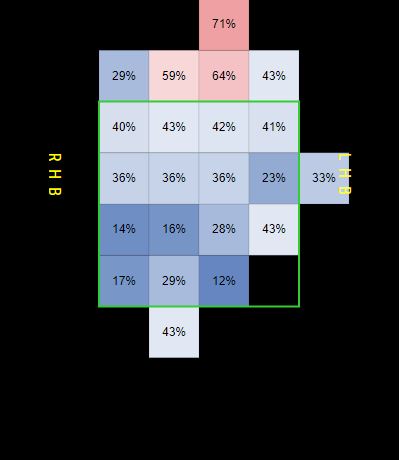
CHART 3
Again, we see Hader gets the best results up in the zone with his fastball. And this is in spite of his below-average spin rate and BU.
For reference, Chart 4 displays the top ten and bottom five wFB scores with the ratio of high fastballs, average spin rate, and BU score.
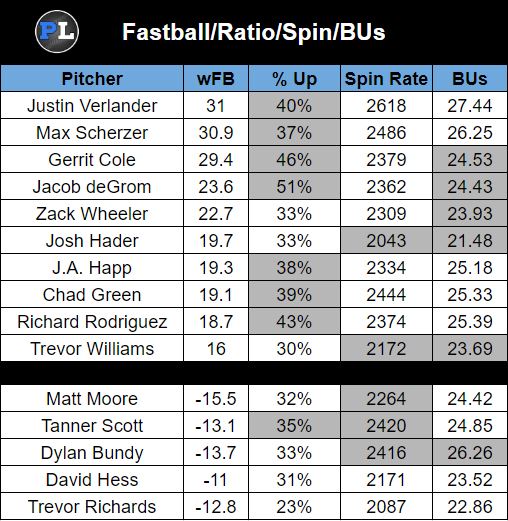
CHART 4
We see that only Zack Wheeler, Trevor Williams, and Hader all throw their fastballs up less than the league average of 34%. The bottom five’s Tanner Scott is above average. Only two pitchers (Hader and Williams) have a below average spin rate, while the bottom three in wFB have above average spin rates. Gerrit Cole, Jacob deGrom, Wheeler, Hader, and Williams have average or below BU scores, along with Dylan Bundy among the bottom five.
But we can’t rely on spin rate and Bauer Units alone. We have to take movement into consideration, right? Let’s look at Brooks Baseball’s Pitch IQ evaluation of fastball movement. To summarize, Pitch IQ normalizes movement in the same way that stats like ERA+ or FIP- do. A score of 100 would be considered league average, with anything above or below being above average movement and vice versa. To attempt to rank movement, I averaged out the movement scores. For context, the more overall movement, the better; a pitcher with great horizontal movement would be balanced out by weak vertical movement.
Of the top 20 wFB scores of 2018, Chart 5 shows the top ten average Pitch IQ scores.
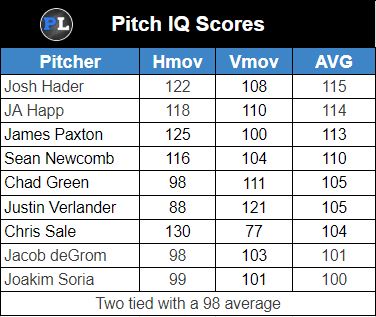
CHART 5
You’ll notice that there are several top-tier pitchers present in Chart 5. Can we assume that the movement they get on their fastballs makes the difference? Not exactly. When looking at the five worst wFB scores, four out of the five pitchers have above average overall movement on their pitches. Even pitchers with average fastball value don’t provide any conclusive evidence when reviewing their average movement score.
So where does that leave us? We can reasonably say that high spin doesn’t always make the difference, nor high velocity in tandem with spin (BUs). And movement can’t exactly be pointed to either. That doesn’t mean they are mutually exclusive metrics, either. Overall, location tends to matter more than anything else. Its great to have high velocity, an applicable spin rate, and movement. If you don’t locate, it’s all moot. In this case, looking at four-seam fastballs, its a clear advantage to throw up in the zone instead of down. Charts 6 and 7 display league-wide whiff rate and batting average against, respectively.

CHART 6
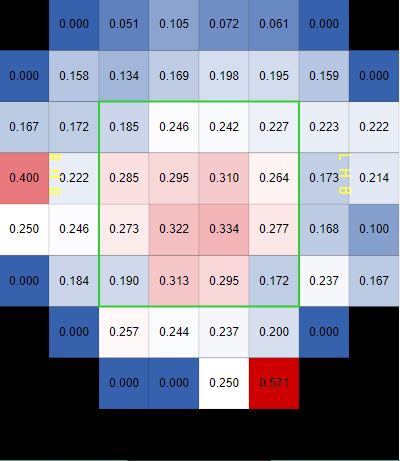
CHART 7
Placing a fastball high(er) in the zone, mainly up and in to hitters a la Effective Velocity standards, sets up breaking or off-speed pitch tunnels. Sequencing and tools such as creating pitch tunnels also factor in. According to Ev developer Perry Husband, Throwing up and in to a hitter can add as much as 4-5 MPH to a fastball in relation to reaction time to make positive contact. Anything down and/or away can actually subtract velocity thereby creating a spread larger than the radar gun is telling you in a hitter’s mind’s eye. An up (and in) fastball at 90 MPH can register up to 95 EvMPH depending on location and a curve (for example) down and away at 80 MPH can actually drop to 75 EvMPH. While both spreads are large, the further apart they get, the more the hitter’s attention zone has to account for. What’s more is if these pitches are tunneled properly, the hitter stands very little chance to be successful during their at-bat.
Its important for a pitcher to be aware of velocity spreads that can be created by putting a ball in certain locations. You can throw a fastball as hard as you want or create movement with spin rate (and axis), but if you can’t locate properly, you’re not going to last long. The aforementioned lowest-tier fastballs (Matt Moore, Scott, Bundy, Jordan Zimmerman, etc) have above average velocity, spin rate, and BU scores, yet they aren’t successful. And I have to reiterate that those things do have their place; knowing how your spin works with your velocity can be valuable information.
As an example, a query I ran on fastball value scaled to 100 (FA) pitches (wFA/C) in relation to velocity, just over a third of the top-30 performers had fastball speeds that were at or below average (92 MPH). You can’t expect that just because you throw 100 MPH, you can regularly blow hitters away. Or that you create a ton of movement, therefore you’ll always be able to throw a hitter off no matter how or when it’s used.
What’s the ‘x’ factor? Proper pitch location in conjunction with Ev tunneling (e.g.- high fastballs, away breaking pitches, down off-speed,) should always be given priority over velocity, spin, etc. Knowing this frees you from the stigma of needing high velocity and good movement to succeed. They make your weapons better but it won’t matter if you don’t use them properly.
Photo by Jimmy Simmons/Icon Sportswire


Great post.
Pitching up in the zone increases whiff rates substantially over low in the zone (as much 2-3x on four seamers). I’m beginning to think pitchers should abandon low in the zone four seamers altogether. Use your breaking pitches down there!
However, we shouldn’t undersell the importance of velocity. The relationship between fastball velocity and fastball effectiveness is very robust and directly linear. An 88-89 MPH four seamer in the top of the zone has a .423 wOBA and 11.7% SwStk. A 94-95 MPH ball is at .297 and 20.1%. A 98-99 MPH ball is at .233 and 24.4%.
Ah, but as I stated in the article, sequencing is vital. Pitchers can succeed with sub-95, even high 80s if they use the pitch right (it will of course be MUCH harder). I’d like to look into that to see the context of that contact data.
Thanks as always for the feedback!
Totally agree. Pitchers need to pitch. Isn’t just about throwing hard.
However, the data on velocity is as clear as you can get that more velocity = good, less velocity = bad. Unfortunately a lot of pitchers with good velocity might not focus as much on EV / liquid analytics as they should. Sometimes it probably takes losing some of their natural ability to rethink their approach. But if you took two pitchers who are equally adept at sequencing and tunneling, the guy with 2 MPH more on his fastball wins every time.
Below is how league performed on four-seamers in the upper third of the zone last year in terms of wOBA and SwStk.
https://imgur.com/dGYLj8X
I do believe velocity is a good thing; a guy who tops out at 85 will have a very hard time making it in MLB. What I’m alluding to is that you don’t need to have a 95+ MPH fastball to succeed. I think that there shouldn’t be such a high emphasis on velo.
And as far as that data you linked in the last comment, I was thinking more along the lines of when those pitches are thrown during an at-bat. As in are these numbers reflected earlier in the count? Late in the count? What did he throw before/after? Where did he locate? And upper third, is that counting both in and out of the zone? Not trying to devalue what you’re saying, I just want to be sure I’m taking the context the right way.
Take the Cards Jordan Hicks. Dude can fire his sinker to the plate w a 101 MPH average velo. But, it’s rating (1.08 wSI/C) was only a bit above league-average (his four-seam was not good at all). Hicks’ slider was actually his most effective pitch in terms of value, which has a lot to do with how it plays off his sinker. Brad Ziegler (for example) throws his sinker about 85 MPH and had its value rated just about the same (1.06). Same w Adam Cimber (1.04) throwing 87 MPH. Its all in how you use the pitch w the rest of your repitoire.
You need context with pitching stats; it matters in the sense that its a little inflexible to believe a pitcher lives and dies with his fastball (not to put words in your mouth). All of this is why I like the PI Pitch Value system that Fangraphs provides. It’s not ideal but its close.
Regardless you’ve given me some things to think about!
The presented figures are four seamers in the upper third of the strike zone – game day zones 1, 2 and 3 on Savant. I isolated the upper third because, as you know, location matters in terms of success, so I wanted to an apples to apples comparison. I understand how context matters, but when you see such a clear relationship on a league wide level between velocity and success, it means to me that velocity is very important.
I suspect Hicks’ fastball doesn’t look great because it’s a two seamer that he throws in the middle of the strike zone. To your point, if you just chuck the ball around without a plan, regardless of velocity, hitters will feast. But that doesn’t mean we should understate the important of velocity.
I don’t know enough about the Fangraphs PI figures but I generally don’t think looking at a season’s worth of pitch value data for an individual pitcher is that instructive (did Trevor Williams really have the 5th best fastball in 2018?). I’d rather look at benchmarks for how the league performs against different pitches at different velos in different locations and then see how pitchers mirror or deviate from that.
Fair enough. We simply look at it in different ways and that’s fine. I never said it didn’t matter or that its an afterthought. I don’t think I’m trying to understate it as much as you think. High velo=high success but is it ONLY because of velocity? Or does pitch mix, location, or other metrics I discuss play a part too? Of course they do. I’m in the camp that believes location trumps velocity. In a lot of cases, not all.
Just for posterity, here are the average FB velocities (min 1000 pitches) for the 2018 season: https://atmlb.com/2rJOH3u
Note the pitchers that throw 90 or under. Lots of great pitchers that throw over 90, too. But you have to take into consideration the other pitches they throw and how they work together. If velocity matters (as much as I presume you’re implying), all the kids in the minors who throw 100+ would be in MLB? Why doesn’t everyone who throws over 95 or whatever just throw fastballs if they get great results? They can’t. They have to use other pitches and have to throw strikes. And its how they use those other pitches that can make the fastball a strong pitch for them (see Trevor Williams, who rates 10th, not 5th min 50 innings pitched). Velocity and control are not mutually exclusive, which is obvious to both of us.
Hicks throws his FB the most to zone 11 (19%) with zones 4-5-6 combined totaling 20%. He doesn’t have great control (rated a 40/80, 13.3% BB-rate in 2018) and only throws his supplemental pitches 25% of the time. With better control and a better pitch mix, he’d probably be almost unhittable.
TL;DR- agree to disagree. And that’s a good thing!
What do you mean by sequencing? Can you give some specific examples?
Well, Max Scherzer is a good example of a pitcher who sequences well.
Up and in fastball @ 95MPH-> Down changeup @ 82MPH-> Inside (or up and away) FB @ 95MPH-> Slider away @ 90MPH-> Changeup down @ 82MPH-> Fastball up @95MPH. Something like that where you change eye levels and spread velocity while taking into account the pitches Effective Velocity.
If you throw three fastballs in a row to the same general location (when explaining why a guy got hit hard) w the same velo, a (good hitter) will catch up. Statistically speaking, you can’t necessarily point to a bad BAA vs fastball, it’s more that he isn’t changing locations/eye level nor spreading his velocity. The pitch may be amazing (fast, good movement) but he isn’t using it correctly.